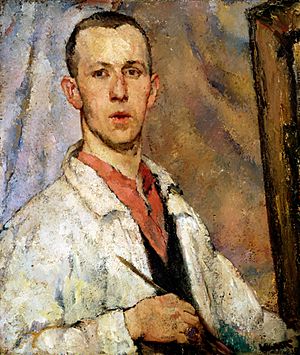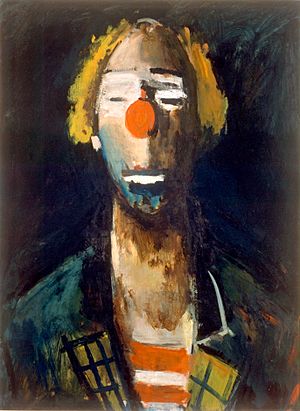Joseph Kutter facts for kids
Quick facts for kids
Joseph J F Kutter
|
|
|---|---|

Self portrait
|
|
| Born | December 12, 1894 |
| Died | January 2, 1941 (aged 46) |
| Movement | Expressionism |
Joseph Jean Ferdinand Kutter (1894–1941) was a very important painter from Luxembourg. He was inspired by a style called Impressionism. But he soon developed his own unique style, known as Expressionism.
Contents
Early Life and Art Studies
Joseph Kutter was born in Luxembourg City on December 12, 1894. His father, Paul Kutter, was a well-known photographer in the city. Joseph wanted to be a painter.
He first went to an art school in Luxembourg. Then he studied decorative art in Strasbourg and Munich. From 1917 to 1918, he studied at the Academy of Fine Arts, Munich. Here, he learned about a painting style inspired by Wilhelm Leibl.
Becoming a Famous Artist
After 1919, Joseph Kutter was greatly influenced by Paul Cézanne. He started showing his paintings at art exhibitions in Munich. From 1925, he became very interested in Flemish Expressionism. This art style was popular in Belgium and France.
A Belgian art critic named André de Ridder encouraged Kutter. So, Kutter showed his work at the 1926 Salon d'Automne in Paris. In the same year, he helped start a new art group in Luxembourg called the Salon de la Sécession. He showed his art at their first exhibition in 1927.
Kutter also kept showing his paintings regularly at the Salon d'automne in Paris. People in France and Belgium recognized his talent. However, his art was not as well-known in Germany. In 1933, he stopped showing his art in Germany. This was because the government, led by Hitler, did not approve of his style.
In 1936, Kutter was asked to paint two large artworks. These paintings were of "Luxembourg" and "Clervaux" for the International Exposition in France. While he was working on them, he became very ill. Doctors could not figure out what was wrong. Later, during times when he felt better, he painted his famous clowns. These paintings show his pain and worry. Joseph Kutter passed away on January 2, 1941, in Luxembourg City.
Kutter's Unique Style
In Joseph Kutter's paintings, the main subjects often stand right in front, almost like they are posing for a photograph. His portraits use strong brushstrokes. They often show people with very large noses, which always catches your eye.
After 1918, Kutter's paintings started to show more Expressionist ideas. This was especially true in his landscapes and flower paintings. In these, you can see strong lines and bright colors. Even though Kutter lived in Germany for some years, his art was mostly shaped by trends in France and Belgium.
He focused a lot on painting people. He often showed his subjects as sad or worried clowns. The two large paintings he made for the 1937 World Exposition in Paris are great examples of his mature Expressionist style. In his painting of "Luxembourg," he highlights the way the houses are stacked on hills. He makes the buildings look like strong cubes and shows the power of the old city walls.
Selected Artworks
- The Champion (1932), National Museum of Art and History, Luxembourg. This painting shows the Luxembourg racing cyclist Nicolas Frantz.
- The Wooden Horse (1937), National Museum of Art and History, Luxembourg.
- Luxembourg (1936–37), National Museum of Art and History, Luxembourg.
- Clervaux (1936–37), National Museum of Art and History, Luxembourg.
Images for kids








